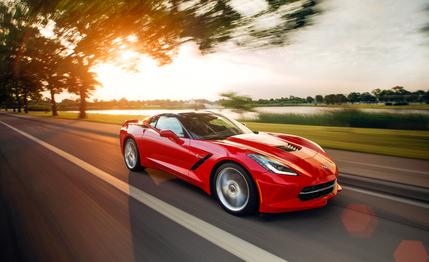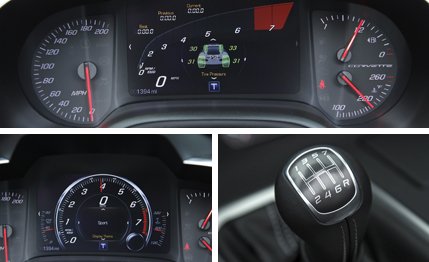 Instrumented Test
Instrumented Test
That whiff of smoked Michelin you smell and the bawl of tortured rear tires you hear confirm that we’ve popped the clutch on the Corvette’s seventh generation. We uncorked it at GM’s Milford, Michigan, proving grounds, where we strapped our testing gear to the thing and came away feeling sorry for almost any car that meets it at a stoplight, the track, or a winding road.
But before we tell you about what it can do, here’s a primer on what makes the C7 worthy of bearing the Corvette flame and the Stingray name. The new LT1 V-8 carries over a 6.2-liter displacement and pushrod architecture but nothing else. Direct injection and optimized combustion hike the power to 460 horses while fluffing the torque curve by 50 pound-feet between 2000 and 3500 rpm. Cylinder shutdown and a mega-tall seventh gear in the Tremec manual transmission push EPA highway mileage to 30 mpg (in eco mode). A stout aluminum frame and Michelin tires are now standard for all Corvettes. The C7’s tech arsenal includes an electronically controlled limited-slip differential, aerodynamic lessons learned from racing, manual-transmission rev matching, and a patented means of sensing tire temperature to fine-tune the chassis. Inside, the cockpit is comprehensively upgraded, and the sorry C6 buckets have been replaced with world-class, eight-way-adjustable driver and passenger thrones.

Modeled after Porsche 911 buckets, these seats don’t hinder your slide into a cockpit that’s aggressively driver oriented. An instrument cluster to make Nintendo jealous, an eight-inch central touch screen, and a sensible mix of control knobs and buttons reside on the action side of a vertical partition. The passenger gets a comfy place to sit, a couple of grab handles, and temperature-control buttons by the right-side vent. While you can splurge for an $8005 full-leather interior package, the $51,995 base Stingray’s dashtop is wrapped with a stitched and grained “protein” vinyl (a blend of vinyl and silk) good enough to fool a cowhide inspector. Real carbon-fiber accents and a stitched-suede dash-wrap are available options, each of which adds $995 to the sticker. The center half of the instrument cluster is a reconfigurable screen offering a choice of three tach motifs, navigation pointers, g reports, and other essential information. Even the cheapest surface material inside, a sort of powder-coat black paint, feels upscale.

Check out our Corvette Mega-Hub: C1–C7 tests, history, features, and more!
Our test day’s biggest surprise was a curb weight higher than expected. The Z51 Stingray we weighed at Milford crossed the scales at 3444 pounds, about 100 heavier than a C6 Grand Sport (steel space frame, 436 horsepower, Z06 chassis hardware). Offsetting its comprehensive weight-saving measures, the new Corvette is slightly larger, structurally stiffer, and better equipped than its predecessor. The harsh reality is that every feature and function—heated and vented seats, for instance—adds pounds. The saving grace is that this is the first Corvette with a rearward weight bias (49.4 percent front, 50.6 percent rear).
Triggering the clutch at 3700 rpm drops a torque bomb on the rear tires. It produces beneficial wheelspin as the clairvoyant e-differential balances left- and right-side thrust. Without exploiting launch control, which is handy but beatable, we clocked a best sprint to 60 mph of 3.9 seconds and 12.2 seconds at 117 mph in the quarter-mile. In case you’ve fallen behind on your stat-keeping, this is elite territory: about the same as the outgoing Corvette 427 convertible, a few tenths quicker than the Grand Sport, and faster than any Porsche Boxster or Cayman we’ve tested. The foes to avoid at stoplights are the new Jag F-type packing a supercharged V-8 and the Porsche 911S, both of which smoke the Stingray to 60 and through the quarter-mile by 0.2 to 0.3 second.